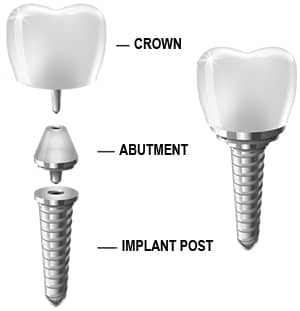If you have lost one or more teeth or are facing tooth loss in the near future, you might have begun to investigate ways to replace them. A great solution is to use dental implants, and this option might be appealing if you are interested in the most technologically advanced way to restore your smile.
However, many people are a little confused as to exactly what is a dental implant and why this is frequently the preferred treatment choice.
Although our implant dentists in Yonkers Dr. Yana Rosenstein DDS, Dr. John Habib DDS and Dr. Fadi Beydoun DDS can explain dental implants in more detail during your initial consultation, this article will provide you with some useful information. Afterward, you will have a better idea as to what exactly is an implant and how it works.
The first thing to understand is:
- construction of a dental implant
- materials it is made fro
- components of dental implant
- how each component work together, providing the foundation for your new smil
Understanding Dental Implant Materials
Most dental implants are made from medical-grade titanium alloy. This is the same quality of alloy used in other medical components such as replacement joints.
Titanium is chosen because it is highly biocompatible and fuses extremely well with natural bone.
Zirconia. It is possible for dental implant components to be made from a hard, all-ceramic material called zirconia, but this treatment is far less common compared to titanium alloy implants.
Titanium is highly biocompatible, and it would be extremely rare for anyone to have an allergic reaction to this material. Titanium implants have been extensively studied and tested for decades. In comparison, zirconia implants are relatively new so far less is known about this treatment.

Conventional dental implants consist of three separate components. These components are:
- implant post
- abutment
- restoration which is the crown, bridge or denture that will be supported by the implant or with multiple implants.
Read more: How many dental implants do you need for a denture or fixed bridge?
The Implant Post
The first component is the titanium alloy post that is surgically inserted directly into your jawbone. The ability to bond strongly to bone is integral to the success of implant treatment and is the reason why it’s necessary to use such a biocompatible material.
This enables a process called osseointegration to take place and is where new bone cells begin to grow around the implant post and actually on the post itself.
As this new bone growth occurs, it gradually ensures the implant post is firmly fused to the jawbone, so it cannot move even a millimeter. Often, an implant post is specially treated to encourage this process, for example, the post may be slightly roughened which increases the surface area available for new bone cells. Other times, the implant post may have a special coating to encourage osseointegration.
Osseointegration can take between three and six months to complete and during this period it’s important that the implant post is kept completely stable.
This is why with conventional treatment; the implant post is left undisturbed, but sometimes it is possible to fit temporary or even permanent implant teeth quite soon after treatment, especially if you require a full arch bridge. In this case, the restoration helps to ensure the implants are firmly splinted together, preventing any movement.
However, each implant case is different and your implant dentist will recommend the treatment plan they know will be most successful for your unique needs. Even if your implants can’t be restored until healing is complete, you can always be provided with temporary teeth during this period.
There is no need to worry that you will be left without a smile!
The Abutment
The second component is called an abutment and is attached to the implant post once it has been successfully inserted into your jawbone.
An abutment protrudes slightly above the gums, providing a strong anchorage point for your new restoration.
With conventional dental implant treatment, it may be several months later before an abutment is attached which gives the bone surrounding the dental implant adequate time to heal.
During the healing process the implant post may be covered up with gum tissue or it can be covered with what’s called a healing cap and which may be used to help shape the gum tissue to create a more aesthetically pleasing outcome for treatment.
This helps to ensure that an implant crown is surrounded by a nicely shaped gum, creating the most natural appearance possible.
The type of abutment used does depend on your chosen restoration as the abutments used to support crowns and bridges are quite different compared to the abutments chosen to support dentures.
The Restoration
Single dental implants can be restored with an implant-supported crown
Multiple dental implants can support a dental bridge or even a removable denture.
Whichever restoration is chosen, you can rest assured that it will have been carefully designed to restore full functionality and to ensure excellent aesthetics.
Extensive planning is required for dental implant treatment to ensure each implant is placed in exactly the right position. This makes sure that all essential structures within the jawbone are avoided and which include blood vessels and nerves, and that once the implant treatment is completed, the implant restoration can be designed in such a way to look cosmetically pleasing, while making it easy to bite, chew and speak comfortably.
A well-designed implant restoration will provide the correct support for your cheeks and lips. If you are currently missing multiple teeth or wear ill fitting conventional dentures, then this may even help to create a more youthful appearance, filling out fine lines and wrinkles that can develop when the facial muscles collapse inwards due to lack of support
Are There Any Other Types of Dental Implants?
Yes, as it is possible to have what are called mini dental implants that are narrower in diameter compared to conventional dental implants.
The procedure to insert these types of implants can also be a little different compared to traditional dental implants because they are inserted directly through the gum tissue.
It is also more common for mini dental implants to incorporate the implant post and abutment as a single unit rather than as two separate components.
These types of implants are suitable in specific situations, for example, if you require a lower front tooth to be replaced and where space is extremely limited. In this case, there may be insufficient room for a conventional width implant, but mini dental implants will be the perfect size.
Often mini dental implants are used to stabilize dentures.

